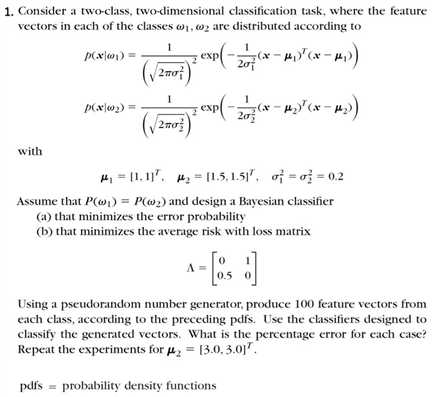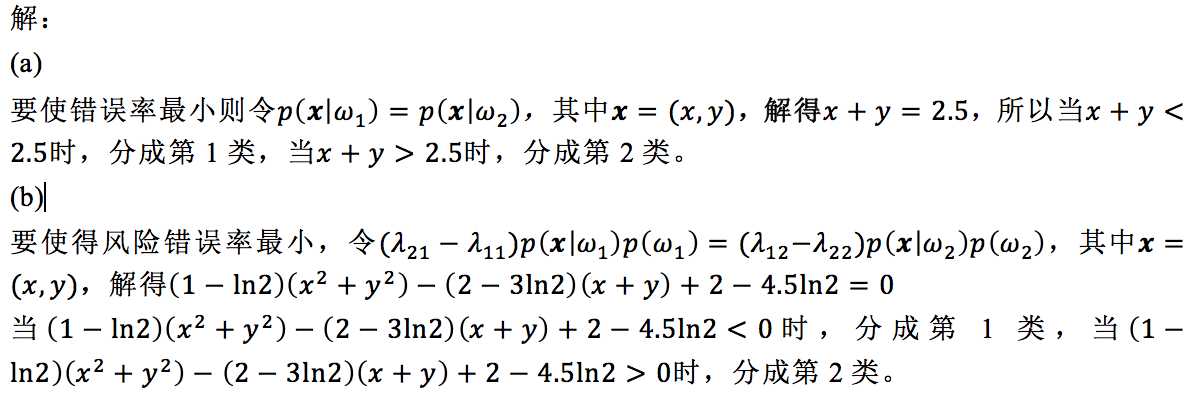标签:参考 poi blog mesh ant att ase ima sig
参考课件:https://wenku.baidu.com/view/c462058f6529647d2728526a.html
错误率最小化和风险最小化


代码:
import numpy as np import matplotlib.pyplot as plt from sklearn.ensemble import AdaBoostClassifier from sklearn.tree import DecisionTreeClassifier from sklearn.datasets import make_gaussian_quantiles # Construct dataset X1, y1 = make_gaussian_quantiles(mean=(1, 1),cov=0.2, n_samples=100, n_features=2, n_classes=1 ) X2, y2 = make_gaussian_quantiles(mean=(1.5, 1.5), cov=0.2, n_samples=100, n_features=2, n_classes=1) X = np.concatenate((X1, X2)) y = np.concatenate((y1, y2+1 )) # for class 1 error errorNum = 0 for i in range(len(X)): if y[i] == 0 and X[i][0]+X[i][1]>2.5: errorNum += 1 print ‘exp1 error rate for class 1 is ‘+str(errorNum)+‘%‘ # for class 2 error errorNum = 0 for i in range(len(X)): if y[i] == 1 and X[i][0]+X[i][1]<2.5: errorNum += 1 print ‘exp1 error rate for class 2 is ‘+str(errorNum)+‘%‘ # for class 1 risk errorNum = 0 for i in range(len(X)): if y[i] == 0 and 0.368528*(X[i][0]*X[i][0]+X[i][1]*X[i][1])+0.07944*(X[i][0]+X[i][1])-1.119>0: errorNum += 1 print ‘exp1 risk error rate for class 1 is ‘+str(errorNum)+‘%‘ # for class 2 risk errorNum = 0 for i in range(len(X)): if y[i] == 1 and 0.368528*(X[i][0]*X[i][0]+X[i][1]*X[i][1])+0.07944*(X[i][0]+X[i][1])-1.119<0: errorNum += 1 print ‘exp1 risk error rate for class 2 is ‘+str(errorNum)+‘%‘ plot_colors = "br" plot_step = 0.02 class_names = "AB" plt.figure(figsize=(8, 8)) # Plot the decision boundaries plt.subplot(221) x_min, x_max = X[:, 0].min() - 1, X[:, 0].max() + 1 y_min, y_max = X[:, 1].min() - 1, X[:, 1].max() + 1 xx, yy = np.meshgrid(np.arange(x_min, x_max, plot_step), np.arange(y_min, y_max, plot_step)) Z = np.sign(xx+yy-2.5) cs = plt.contourf(xx, yy, Z, cmap=plt.cm.Paired) plt.axis("tight") # Plot the training points for i, n, c in zip(range(2), class_names, plot_colors): idx = np.where(y == i) plt.scatter(X[idx, 0], X[idx, 1], c=c, cmap=plt.cm.Paired, label="Class %s" % n) plt.xlim(x_min, x_max) plt.ylim(y_min, y_max) plt.legend(loc=‘upper right‘) plt.xlabel(‘x‘) plt.ylabel(‘y‘) plt.title(‘exp1 mini error‘) plt.subplot(222) x_min, x_max = X[:, 0].min() - 1, X[:, 0].max() + 1 y_min, y_max = X[:, 1].min() - 1, X[:, 1].max() + 1 xx, yy = np.meshgrid(np.arange(x_min, x_max, plot_step), np.arange(y_min, y_max, plot_step)) Z = np.sign(0.368528*(xx*xx+yy*yy)+0.07944*(xx+yy)-1.119) cs = plt.contourf(xx, yy, Z, cmap=plt.cm.Paired) plt.axis("tight") # Plot the training points for i, n, c in zip(range(2), class_names, plot_colors): idx = np.where(y == i) plt.scatter(X[idx, 0], X[idx, 1], c=c, cmap=plt.cm.Paired, label="Class %s" % n) plt.xlim(x_min, x_max) plt.ylim(y_min, y_max) plt.legend(loc=‘upper right‘) plt.xlabel(‘x‘) plt.ylabel(‘y‘) plt.title(‘exp1 mini risk‘) ############################################################################### # Construct dataset X1, y1 = make_gaussian_quantiles(mean=(1, 1),cov=0.2, n_samples=100, n_features=2, n_classes=1 ) X2, y2 = make_gaussian_quantiles(mean=(3, 3), cov=0.2, n_samples=100, n_features=2, n_classes=1) X = np.concatenate((X1, X2)) y = np.concatenate((y1, y2+1)) # for class 1 error errorNum = 0 for i in range(len(X)): if y[i] == 0 and X[i][0]+X[i][1]>4: errorNum += 1 print ‘exp2 error rate for class 1 is ‘+str(errorNum)+‘%‘ # for class 2 error errorNum = 0 for i in range(len(X)): if y[i] == 1 and X[i][0]+X[i][1]<4: errorNum += 1 print ‘exp2 error rate for class 2 is ‘+str(errorNum)+‘%‘ # for class 1 risk errorNum = 0 for i in range(len(X)): if y[i] == 0 and 0.368528*(X[i][0]*X[i][0]+X[i][1]*X[i][1])+2.15888*(X[i][0]+X[i][1])-10.4766>0: errorNum += 1 print ‘exp2 risk error rate for class 1 is ‘+str(errorNum)+‘%‘ # for class 2 risk errorNum = 0 for i in range(len(X)): if y[i] == 1 and 0.368528*(X[i][0]*X[i][0]+X[i][1]*X[i][1])+2.15888*(X[i][0]+X[i][1])-10.4766<0: errorNum += 1 print ‘exp2 risk error rate for class 2 is ‘+str(errorNum)+‘%‘ # Plot the decision boundaries plt.subplot(223) x_min, x_max = X[:, 0].min() - 1, X[:, 0].max() + 1 y_min, y_max = X[:, 1].min() - 1, X[:, 1].max() + 1 xx, yy = np.meshgrid(np.arange(x_min, x_max, plot_step), np.arange(y_min, y_max, plot_step)) Z = np.sign(xx+yy-4) cs = plt.contourf(xx, yy, Z, cmap=plt.cm.Paired) plt.axis("tight") # Plot the training points for i, n, c in zip(range(2), class_names, plot_colors): idx = np.where(y == i) plt.scatter(X[idx, 0], X[idx, 1], c=c, cmap=plt.cm.Paired, label="Class %s" % n) plt.xlim(x_min, x_max) plt.ylim(y_min, y_max) plt.legend(loc=‘upper right‘) plt.xlabel(‘x‘) plt.ylabel(‘y‘) plt.title(‘exp2 mini error‘) plt.subplot(224) x_min, x_max = X[:, 0].min() - 1, X[:, 0].max() + 1 y_min, y_max = X[:, 1].min() - 1, X[:, 1].max() + 1 xx, yy = np.meshgrid(np.arange(x_min, x_max, plot_step), np.arange(y_min, y_max, plot_step)) Z = np.sign(0.368528*(xx*xx+yy*yy)+2.15888*(xx+yy)-10.4766) cs = plt.contourf(xx, yy, Z, cmap=plt.cm.Paired) plt.axis("tight") # Plot the training points for i, n, c in zip(range(2), class_names, plot_colors): idx = np.where(y == i) plt.scatter(X[idx, 0], X[idx, 1], c=c, cmap=plt.cm.Paired, label="Class %s" % n) plt.xlim(x_min, x_max) plt.ylim(y_min, y_max) plt.legend(loc=‘upper right‘) plt.xlabel(‘x‘) plt.ylabel(‘y‘) plt.title(‘exp2 mini risk‘) plt.tight_layout() plt.subplots_adjust(wspace=0.35) plt.show()
标签:参考 poi blog mesh ant att ase ima sig
原文地址:http://www.cnblogs.com/huangshiyu13/p/6537815.html